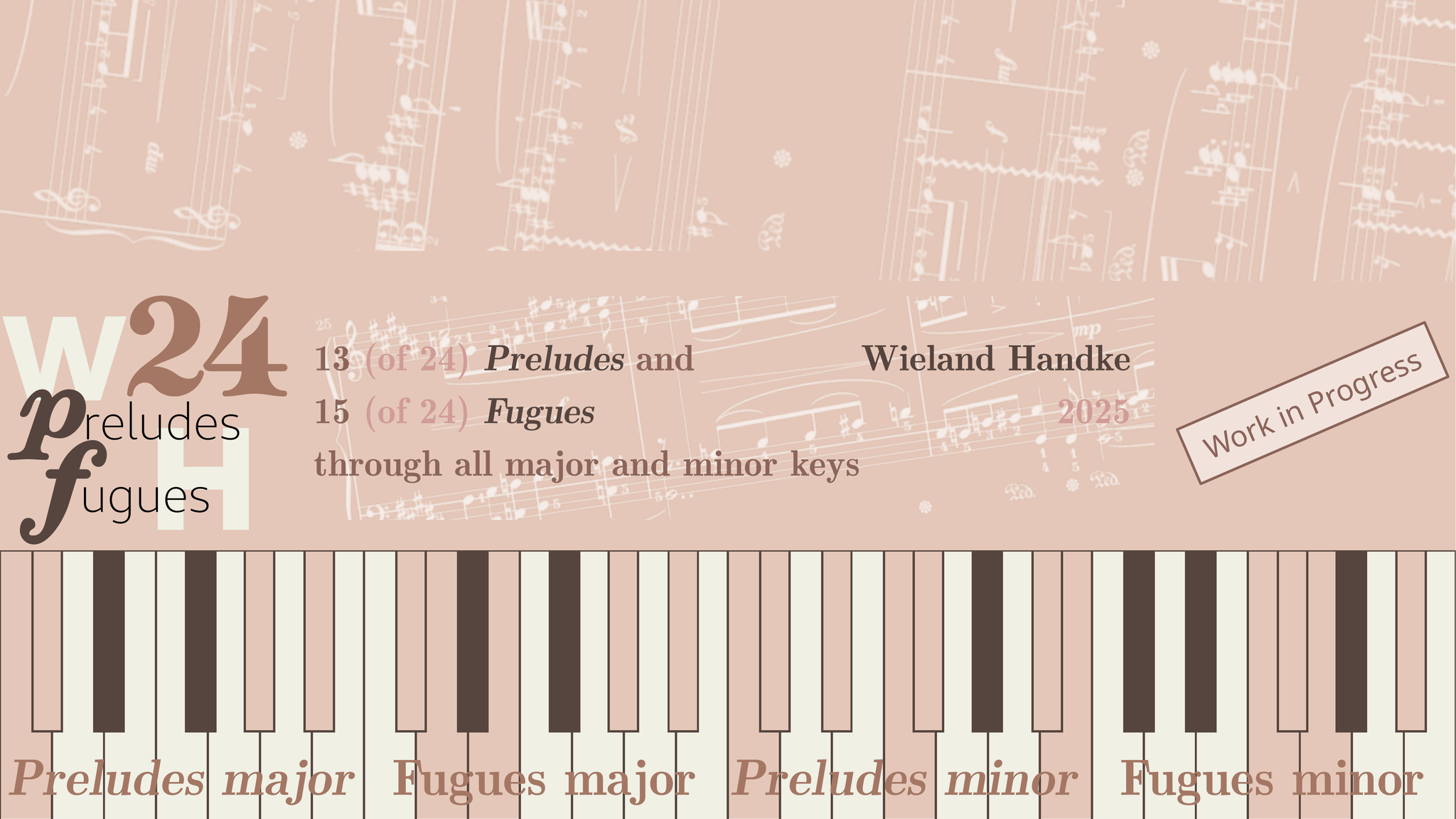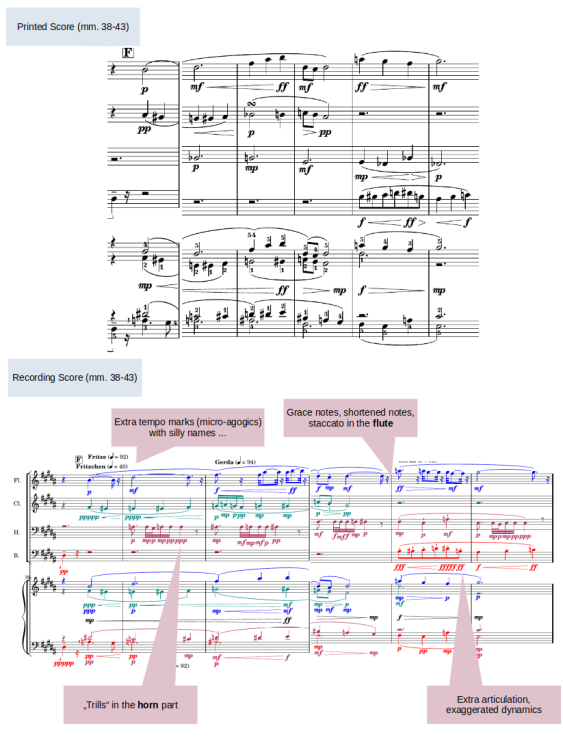-
Posts
26 -
Joined
-
Last visited
About Wieland Handke

Profile Information
-
Gender
Male
Recent Profile Visitors
Wieland Handke's Achievements
-

2025 Christmas Music Event!
Wieland Handke replied to PeterthePapercomPoser's topic in Monthly Competitions
I would enjoy to participate in this event, too. I hope that I can accomplish my contribution within the next two weeks. Looking forward for listening and reviewing the contributions of other participants -
Wieland Handke started following 2025 Christmas Music Event!
-
Wieland Handke started following From Above, Now Below (Submission) , Exposition of Fugue in D major - WIP , 2025 Halloween Satisfaction Survey and 5 others
-
After the tense Halloween competition I needed some time to relax, and what better way to do that than to compose a new piece? So today, I'm taking the opportunity to present my first steps here as a “work in progress” in order to get feedback before I finish it (since it's sometimes difficult to incorporate suggestions after that). First some background about the ideas I had in mind for this piece: As often, I would take the challenge to use an odd meter, therefore here in 10/8 introducing a 5-beat rhythm. There were also some pieces in my mind which would influence the idea and texture of the fugue: In Leonhard Bernstein’s „Chichester Psalms“ there is a movement in 10/4 meter with very slow slurs, a slur spanning 5 notes, and below that 2 small slurs, each spanning 2 and 3 notes respectively. https://youtu.be/PnrZGTmMjYc?t=728 On the other hand, Bach’s „Et in terra pax“ from the b minor mass also has that slow-flowing mood with tied second steps (while in 4/4 time) and is a wonderful example for the festive D major. https://youtu.be/p16wOPrX7Rk?t=104 The third piece I had in mind is Bach’s G sharp minor fugue, BWV 887, from WTC2. It has a continuous texture of 8th notes (here in 6/8 time) and is a perfect example for rhythmic counterpoint in such a texture. https://youtu.be/1iHpPR9xzk8?t=115 And there is the „funny“ fugue in A major from Shostakovich’s op 87 which has a subject which is usually not a real fugue subject since it consist only of very consonant chord arpeggios, however in the end it is a marvelous fugue with a wonderful harmony and texture! https://youtu.be/Qe1vF0bgmb4 So I present here the fugue exposition (and the first episode). The subject (in its first entry) is in D lydian, but modulates to a repetition of first motif in E major as the end of the subject (so its easy for the answer to enter in A major, finally modulating to b minor). After the second entry of the subject there is a short codetta modulating to c sharp minor, so that the third entry of the subject in D lydian produces an interesting appearence as Neapolitan chord. Apart from the harmony, it was a challenge for the counterpoint to find rhythmic patterns that create an interesting overall texture on the one hand, but do not destabilize the 10/8 rhythm on the other.
-

2025 Halloween Satisfaction Survey
Wieland Handke replied to PeterthePapercomPoser's topic in Monthly Competitions
Oh no! I liked all the pieces very much. Your „Trio Variations” are neither „terrifying“ nor too „well-behaved”; I find them „good balanced.” That's why I placed them in the third category, right next to my own. (Hahaha, you voted for yourself ...) -

2025 Halloween Satisfaction Survey
Wieland Handke replied to PeterthePapercomPoser's topic in Monthly Competitions
First of all, I have to say that I really enjoyed this competition! It was an intense two weeks—on the one hand, to finish my own composition/arrangement, and on the other hand, to listen to such a diverse range of great musical works. I think all the participants invested a lot of time, effort, and passion to achieve such a result! I must admit that – puh – reviewing seems to be harder than composing! We have seen a lot of atonality and non-traditional musical structure (to mention some, but not to be exhaustive all "Dima’s National Dance" by @Dima, "From Above, Now Below" by @Thatguy v2.0, "Diptych for Piano Quartet" by @Cosmia, "Aos Si" by @HoYin Cheung, "American Cryptids" by @Micah, "Fumage" by @Justin Gruber, "Clowns" by @sebastian Pafundo, "Woodwind Quintet" by @Maxthemusicenthusiast, "The Mist" by @Kvothe, "A Hollow Theme for Halloween" by @therealAJGS) and – on the other hand – more „beautiful“ and „well-behaved“ pieces (for example, "Ghost Town Requiem" by @UncleRed99, "Bagatelle No. 6" by @Omicronrg9 and "Dance from the skeleton ball" by @MK_Piano), which I very enjoyed, too. As „balanced“ between this two poles I would consider "Daunting Steps" by @ferrum.wav, "Trio Variations" by @TristanTheTristan and – lol - my own piece. Therefore, the decision was very hard and due to the subject of the competition, Halloween, the more outlandish pieces were in the better position. The dedications of the badges „spookiest/scariest piece“, „strangest/weirdest/most outlandish piece“ and „biggest thriller“ were – in my opinion – not so easy to distinguish, so that we have one glorious winner in nearly all categories, "From Above, Now Below" by @Thatguy v2.0, my best congratulations. Special thanks to @PeterthePapercomPoser for organizing that funny contest! What did you think of the official competition reviewing template? For me, the competition reviewing template was very useful, giving the focus what to review a clear structure. Even if I did not give a textual review according to the eight categories but only a general one, scoring according to the definitions (i.e. between 0 and 10 points) and calculating an average was useful and helped to determine the winner(s) for the different badges. I could also imagine that in future competitions, the template and the numbers will be used in an official sheet to determine the overall winner. In such a case, however, it would be necessary to formulate more precisely how we should award the points in order to achieve a fair result that can be used for such a calculation. I noticed that some of the reviewers often awarded 10 points to pieces/categories they liked, while I was a bit stingy with this top score (apologies to all participants). I would like to say that such differences in the use of scores between different reviewers, although consistent in their own assessment, could lead to a kind of injustice. What would you like to see in future competitions? I think, the most revenue of the competition is getting a lot of review in a short period of time. Therefore, I would like to keep the competition „just for fun“ without monetary awards. An interesting variant could be to keep the competitors and judges anonymous. Such a rule could be combined with the mandatory use of the template and its usage for the calculation of the winner, as mentioned above. In such a case it would be necessary to require that all participants review all the other entries to achieve comparability and fairness. However, such a strict set of rules could imply that some members would hesitate to participate, thus we could try out that for one competition, but should not apply it to all future ones. -
First the short answer: Thank you for your profound review! I’m impressed how thoroughly you listen to the pieces finding out the least details and accurately identify the weaknesses. Yes, there are some grace notes and other small, detailed differences between the score and the recording. Now the detailed answer: Something about how I work when composing. I use lilypond as the notation software which is quite different than the most other ones. Rather than having a Graphical User Interface the music is typed in in a text file – similarly to writing a computer program. The lilypond software than produces the score and a MIDI file from that input, whereas the MIDI file is afterwards used to produce the recording applying soundfonts for the respective instruments. I do not use any virtual instrument plugins to polish the final recording, clicking on different knobs and controls. Since the recording from the plain MIDI file sounds boring and unrealistic, I started to write different versions (with „ifdefs“) in my lilypond source file, one intended for the printed score and one for the recording, where I for example add fingerings for the printed score and more exact and detailed articulation, dynamics, agogics and arpeggiation for the final music to be hered. For the latter case I slip into the role of the interpreter/performer writing down exactly – note by note – how I would phrase or articulate a distinct passage, how trills, arpeggios or ornamentations would be performed exactly etc. The resulting performance-score is therefore overloaded and nearly unreadable, but it gives a visual feedback with which details a human player would perform the piece. And the most benefit of this approach is, that this final polishing is reproducible whenever I make some corrections/changes in the piece, since both the composition as is and the performing hints reside together in on source file. I think this approach is permissible and reflects the reality. A human performer does literally not play one note as written in the score, but introduces that kind of microdynamic, microagogics or microarticulation deviations which finally produces the intended interpretation. What concerning the actual piece, I made such deviations especially for the flute and the horn. I don’t have experience with woodwind instruments, only that „virtual“ ones coming from listening the output from the MIDI file and the respective soundfonts. I discovered the following effects I wanted to mitigate with my „microarticulation“: The flute has only a small range of dynamics and when playing „medium long notes“ (in this case quarter notes) the sound was sometimes very unrealistic (i.e. MIDI like). So I introduced the grace notes as a kind of interpretation or ornamentation of the flute-player puppet which, in my taste, worked around well. The horn was difficult with long notes, the sound became louder and louder the longer the tone was played, as least with the soundfonts I tried out. I don’t know – and therefore formulated as a question – does the horn behave so in reality? To mitigate that loud blaring, I reduced the dynamics of the long notes drastically and sometimes I introduced a „trill“ to stop that loud blaring sound.
-

YCF Composition Competition - Halloween 2025 (Submission)
Wieland Handke replied to UncleRed99's topic in Chamber Music
The instrumentation choice is perfect! I like the bassoon and the base clarinet introducing their own dark personalities. In contrast to so many other atonal submissions, this piece has clear melodies and harmonies and the Halloweenish timbre is almost accomplished entirely through the expressiveness of the bass instruments, without overstressing dissonances. The dance starting in section C (especially with the triplets from bar 36 on) introduces a feeling of awkwardness, raising the image of mysterious creatures wiggling around. All in all a piece I liked very much, but I must admit that it in the sense of the contest and in the context of the other submissions, it is – for my taste – a little too well-behaved and the blending of all instruments together seems too „perfect“, in order to get the award of the „most scary and spooky“ one. By the way, the title „Ghost Town Requiem“ is – in my opinion – a bit too bold, but what matters. Melodies Themes Motives Harmony Chords Textures Form Development Structure Time Originality Creativity Score Presentation Instrumentation Orchestration Playability Execution of Given Challenge Taste 9 8.5 7 9 9 9 6 7.5 Average Score: 8.125 -

Diptych for Piano Quartet (Submission)
Wieland Handke replied to Cosmia's topic in Competition Hall of Fame
As in your title - „Diptych“ - and your explanation, that you’ve being inspired by paintings of Bacon and Goya, the piece is creating impressions – not necessarily as martially and threatening as the two respective ones – but really fitting the mood of Halloween. For this purpose, the atonality and the lack of a distinct traditional musical form is intentional and well chosen. The articulation and even the advanced string techniques are clearly presented and annotated in the score, convincing that it is not only „experimental music“, but really playable. I very enjoyed this probably last - but not least - piece of the contest. Thank you for sharing. Melodies Themes Motives Harmony Chords Textures Form Development Structure Time Originality Creativity Score Presentation Instrumentation Orchestration Playability Execution of Given Challenge Taste 8 8 7.5 9 9 8.5 8 6.5 Average Score: 8.063 -
The instrumentation choice, the mixed quintet, was very clever given you the chance of having so many different combinations and colors with the instruments, so that the excessive occurence of the themes never gets boring or repetitive. I must admit that I have discovered the existence of two clear defined (melodic) subjects only upon second listening (and after reading your form description). Maybe I've listened too many atonal music the last few days. With this in mind I would consider it as a polyphonic piece – not a classical fugue – but a combination of counterpuntual theme development, variations and free or homophonic intermezzos which creates a rich and interesting texture that lets the long (more than 7 min) piece pass flowlessly. One of my top favorites. Melodies Themes Motives Harmony Chords Textures Form Development Structure Time Originality Creativity Score Presentation Instrumentation Orchestration Playability Execution of Given Challenge Taste 9 9 9 9 9 9 7 8 Average Score: 8.625
-

Dima's National Dance - 2025 Halloween Submission
Wieland Handke replied to Dima's topic in Chamber Music
Yes, that’s a folk dance, but a brutal one! With this choice you’ve really matched the objective for a scary, spooky piece in the Halloween contest. The score presentation is clear and very precise, sometimes giving me questions concerning the playability: Where to take up to 10 fingers in one hand by the piano player? (I know, that are „clusters“ to be played with the entire hand or whatever, but some seem to be difficult to achieve with mixed white/black keys as, for example, in bar 190). In spite of the atonality, the texture of the folk dance is perceivable and so the structure of the peace can be followed and remembered by the listener – what is not always the case in „post-tonal“ pieces. Well done. Melodies Themes Motives Harmony Chords Textures Form Development Structure Time Originality Creativity Score Presentation Instrumentation Orchestration Playability Execution of Given Challenge Taste 6.5 6.5 7 9 8 5 9 6.5 Average Score: 7.188 -

American Cryptids - Fall 2025 Halloween Submission
Wieland Handke replied to Micah's topic in Chamber Music
This is a submission I’ve very enjoyed. Usually, in a string quintet the instruments blend more together than in a woodwind one, the sound of your arrangement preserves the personality of the single instruments very well, thus producing imaginations of the creatures you describe in your music – perfectly matching the Halloween theme. Your score looks very professional and clear (even there is a typo in the title: „crytpids“ instead of „cryptids“ 🙂 ) A bit problematic is that its a work with three movements which together exceed the 7min maximum playing time, thus only a 5 for „Form Development, Structure, Time“. Melodies Themes Motives Harmony Chords Textures Form Development Structure Time Originality Creativity Score Presentation Instrumentation Orchestration Playability Execution of Given Challenge Taste 9 9 5 9.5 9 9.5 9 8 Average Score: 8.5 -

From Above, Now Below (Submission)
Wieland Handke replied to Thatguy v2.0's topic in Competition Hall of Fame
Yes, that’s a really Halloween piece. The opening repetitive piano motif reminds me on a big clockwork, the scary strings could be giant insects coming down and threaten me? Run for your life in the Presto section, starting at mm. 41? All in all makes the piece the impression on me to be best fitted as a soundtrack of a spooky movie. Concerning the score - if to be performed - I’m not sure whether the viola player is enjoyed or able to read 8 ledger lines (mm. 116). Melodies Themes Motives Harmony Chords Textures Form Development Structure Time Originality Creativity Score Presentation Instrumentation Orchestration Playability Execution of Given Challenge Taste 8.5 8 6.5 8.5 7 6 9 6.5 Average Score: 7.5 -
Taking into account your profound comments in the competition threads and your professionally skilled background, I don’t feel capable of evaluating your work from the perspective of a judge, so that my comments are imposed solely by my overall impression and taste. As many others already stated, melodies, harmonies and form development are (almost) perfect, so I have nothing more to say. Now to my subjective and taste related comments: For the purpose of the contest to have a piece with grotesque or mysterious Halloween vibes, I think using woodwind instruments could be the much easier choice because of their different timbres. The strings blend much more together in a perfect balance. That might be the reason that I - before looking into the score and discovering the double stops of the viola – sometimes had the feeling to here more than three string instruments. What on the other hand means, that I could imagine that the piece could be performed beautifully by a larger orchestra than that quartet. „Dance from the skeleton ball“ (for my opinion too martially) should be therefore the working title for the piece with respect of this competition only. I think, it is worth to be performed anytime without that particular context, too. Melodies Themes Motives Harmony Chords Textures Form Development Structure Time Originality Creativity Score Presentation Instrumentation Orchestration Playability Execution of Given Challenge Taste 9.5 9.5 10 7.5 9 8.5 7 7.5 Average Score: 8.563
-

A hollow theme for Halloween (Fall 2025 competition)
Wieland Handke replied to therealAJGS's topic in Electronic
Using the key of G sharp minor for a Halloween theme is, in my opinion, a perfect choice, since for me that key has an inherent mystical and gloomy character. The overall character reminds me of a carousel at a fairground or a piece played on a historical mechanical music box. With this in mind, I can really good imagine a Halloween like spectacle. Concerning instrumentation, form development and structure, your submission is a little out of the ordinary. All other participants used the „traditional“ approach – either in tonal or atonal pieces – to use notation software that produces the score (and finally the audio/video). Your usage of „online sequencer“ is perfectly fine to produce the music you like, however implies some difficulties for the comparison: I am not able to judge whether you have met the competition requirements to use a maximum of five different instruments, your choice using different bells and percussion instruments does not let me count them and you have not specified your intent what instruments you present as the five ones, neither in your score nor in an explanation of the submission. The question of score presentation (or even the requirement to have a score at all) has been discussed in the thread already, but without an ordinary score, for example, the playability is hard to evaluate. Melodies Themes Motives Harmony Chords Textures Form Development Structure Time Originality Creativity Score Presentation Instrumentation Orchestration Playability Execution of Given Challenge Taste 7 8 6 7.5 1 5 7 6 Average Score: 5.938 -
Very beautiful, dreamy music. I love the tension between the clean and consonant passages and the dissonant ones, whereas those dissonances are never scary or threatening, they only darken the calm and peaceful character a little. However, since being a beautiful piece of music, it reminds me more of a starry summer night with gold dust falling from the sky and elves playing around than on a misty, windy October evening with sinister creatures. Will say, therefore it does not so perfectly match the objective of the contest to find the "Spookiest/Scariest piece". Nevertheless, the instrumentation with the pizzicato and pearl-like thirds runs on the piano as well as with the pedalling and the reverb perfectly produce the desired mood. One of my absolute favorites! Melodies Themes Motives Harmony Chords Textures Form Development Structure Time Originality Creativity Score Presentation Instrumentation Orchestration Playability Execution of Given Challenge Taste 9 9 9 9 9 9 6 8 Average Score: 8.5
- 18 replies
-
- 3
-

-

-
For me this is a piece with a lot of ideas and potential. The Halloween style is to be achieved by, on the one hand, atonality, and otherwise, through the color of the different articulations which can be performed by string instruments, for example the application of „col legno“. However a lot of that potential has not been risen yet, and small improvements sometimes work wonders. For example, applying dynamics and agogics: I for myself have experienced, that the dynamics and tempo marks one usually applies in the score gives only an overview about the larger development in the sections. However if a human being will play a phrase, there are a lot of „microdynamics“ and „microagogics“ which are applied naturally in order to phrase. I don’t know what notation software you use and which capabilities it provides (I’m using lilypond), but I’m giving nearly every single note its own dynamic hint and even change the tempo slightly nearly any bar to get the sound more realistic. The end is a bit surprising - not to say that it feels to be unfinished at all (that impression corresponds with the fact that its only 02:17 minutes long and, thus, not reaches the minimum of 3 minutes). Melodies Themes Motives Harmony Chords Textures Form Development Structure Time Originality Creativity Score Presentation Instrumentation Orchestration Playability Execution of Given Challenge Taste 7 7 4 7.5 5.5 8 7.5 6.5 Average Score: 6.625



.thumb.png.8b5b433a341551e913a34392660bc95b.png)




